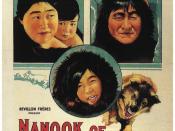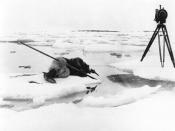In 2002, Robert Kolker claimed in his article 'The "Truth" of The Image', that the image 'is not the thing itself but a thing in itself' . The reading discusses documentary in terms of its representation of images creating a problematic relationship between the constructed image we are shown on screen and the real object. This essay will consider key themes and questions which arise from the reading, including the strengths and weaknesses of Kolker's argument, and will apply it to the documentary film Nanook of the North (Robert J. Flaherty 1922 USA).
Documentary programmes initially appealed to the middle-classes and were intended functionally. They were used for propaganda purposes during the colonisation of nations and the First World War. Documentaries took on the form of illustrated lectures at this time, eventually being replaced post-war by straight documentaries without a lecturer . Documentary as a filmic genre had been defined by John Grierson in 1926 as 'the creative treatment of actuality' , which Brian Winston acknowledged as being problematic because the idea that 'creative treatment' and 'actuality' can co-exist as a genre is inexperienced and duplicitous .
This idea is the basis for Kolker's argument. While language can carry a variety of meanings, visualisations allow us to feel closer to reality, as he says, 'when we approve of the reality of a film, we are really affirming our comfort with it' . Kolker emphasises the fact that once a camera or person intervenes, neutrality is lost and the photograph's objectivity is removed. When audiences see an image on screen, they want to associate it with the real thing so much that they perceive it as being the actual object. While we know that these images are mediated, it is hard to reconcile the artificiality when we see it. Kolker...


